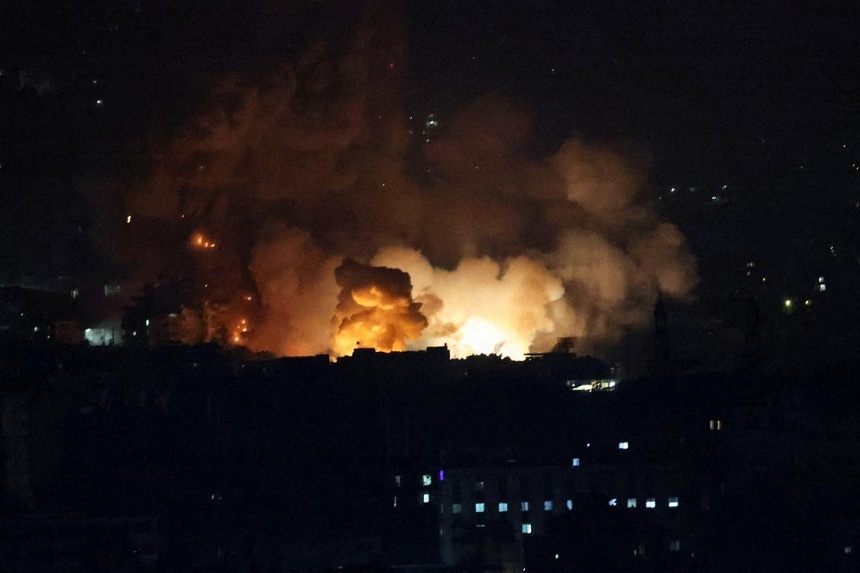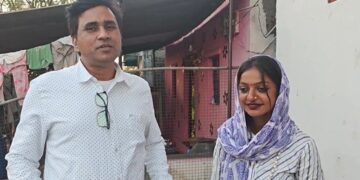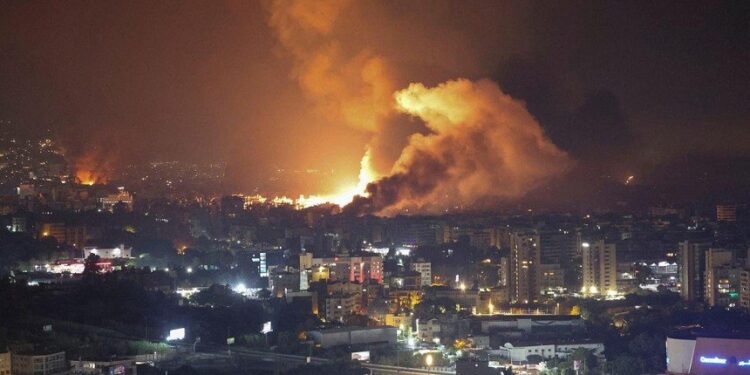BEIRUT/JERUSALEM – A fresh wave of air raids hit Beirut’s southern suburbs in the early hours of Sept 28 as Israel stepped up attacks on Hezbollah, after a massive strike on the Iran-backed movement’s command centre that apparently targeted leader Hassan Nasrallah.
Reuters witnesses heard more than 20 separate airstrikes before dawn on Sept 28. Abandoning their homes in the southern suburbs, thousands of Lebanese congregated in squares, parks and sidewalks in downtown Beirut and seaside areas.
Heavy strikes shook southern Beirut on Sept 27 too. There was no immediate confirmation of Mr Nasrallah’s fate.
But a source close to Hezbollah told Reuters he was not reachable, and the Lebanese armed group had not made a statement.
Israel has not so far said it aimed to hit Mr Nasrallah, but a senior Israeli official said senior Hezbollah commanders were targeted.
“I think it’s too early to say… Sometimes they hide the fact when we succeed,” the Israeli official told reporters when asked if the strike on Sept 27 had killed Mr Nasrallah.
Earlier, a source close to Hezbollah told Reuters that Mr Nasrallah was alive, and Iran’s Tasnim news agency also reported he was safe. A senior Iranian security official told Reuters Tehran was checking his status.
The latest barrage came hours after Israeli Prime Minister Benjamin Netanyahu told the United Nations General Assembly on Sept 27 that his country had a right to continue the campaign.
“As long as Hezbollah chooses the path of war, Israel has no choice, and Israel has every right to remove this threat and return our citizens to their homes safely,” he said.
Several delegations walked out as Mr Netanyahu approached the lectern while supporters in the gallery cheered. He later cut short his trip to New York to return to Israel.
The attack on Sept 27, by far the most powerful by Israel on Beirut during nearly a year of warfare with Hezbollah, marked a sharp escalation of a conflict that has seen a daily missile and rocket fire between the two sides.
Lebanese health authorities confirmed six dead and 91 wounded in the initial attack on Sept 27 – the fourth on Beirut’s Hezbollah-controlled southern suburbs in a week and the heaviest since a 2006 war.

But the final toll appeared likely to be much higher. There was no word on casualties from the later strikes. More than 700 people had been killed in strikes over the past week, authorities said.
Hezbollah’s al-Manar television reported seven buildings were destroyed. Security sources in Lebanon said the target was an area where top Hezbollah officials are usually based.
Al-Manar’s live feed showed search and rescue teams scrambling over concrete and protruding metal, with a correspondent for the TV station saying the attack left several large craters and damaged many surrounding buildings.
Hours later, the Israeli military told residents in parts of Beirut’s southern suburbs to evacuate as it targeted missile launchers and weapons storage sites it said were under civilian housing.

Mr Alaa al-Din Saeed, a resident of the Laylaki neighbourhood which was identified by the IDF as one of those that would be struck, told Reuters that he was fleeing with his wife and three children.
“We found out on the television. There was a huge commotion in the neighbourhood,” he said. The family grabbed clothes, their identification papers and some cash but were stuck in traffic with others trying to flee.
“We’re going to the mountains. We’ll see how to spend the night – and tomorrow we’ll see what we can do.”
This week’s escalation has displaced around 100,000 people in Lebanon, increasing the total number of people uprooted in the country by the conflict to well over 200,000.
Israel’s government has declared returning some 70,000 Israeli evacuees to their homes as a war aim.

Israel’s air defence systems have ensured the damage has so far been minimal.
The latest escalation has sharply increased fears the conflict could spiral out of control, potentially drawing in Iran, Hezbollah’s principal backer, as well as the United States.
Iran, which said the attack crossed “red lines”, accused Israel of using US-made “bunker-busting” bombs in strike on Sept 27, which was much more powerful than other recent attacks.
US Defence Secretary Lloyd Austin said the United States had not been informed of the strike beforehand and President Joe Biden was being informed of developments.
At the United Nations, where the annual General Assembly met this week, the intensification prompted expressions of concern including by France, which with the US has proposed a 21-day ceasefire.
“This must be brought to an end immediately,” French Ambassador Nicolas de Riviere told a Security Council meeting.
At a New York press conference, Secretary of State Antony Blinken said: “We believe the way forward is through diplomacy, not conflict…. We will continue to work intentionally with all parties to urge them to choose that course.”
Hezbollah opened the latest bout in a decades-long conflict by launching a missile barrage against Israel immediately following the Oct 7 attack on Israel by the Palestinian militant group Hamas in Gaza last year. REUTERS





















